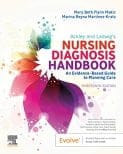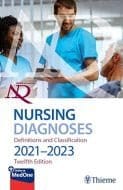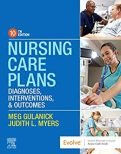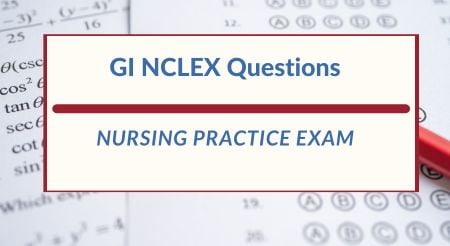GI NCLEX Questions Test Bank
Test your knowledge of gastrointestinal NCLEX Questions. This is set #1. It contains GI NCLEX Practice questions with answers and rationales.
For More GI questions, please see our Gastrointestinal NCLEX Practice Test Page.
Gastrointestinal Nursing Diagnosis and Care Plans
Results
#1. A client with gastroesophageal reflux disease (GERD) is prescribed omeprazole (Prilosec). The nurse understands that the primary action of this medication is:
Reduce gastric acid secretion.
Rationale: Omeprazole is a proton pump inhibitor (PPI) that decreases gastric acid production by inhibiting the proton pump in the parietal cells of the stomach.
#2. A client with peptic ulcer disease (PUD) is complaining of abdominal pain. The nurse should anticipate administering which of the following medications to promote pain relief?
Famotidine (Pepcid).
Rationale: Famotidine is an H2-receptor antagonist that helps reduce stomach acid production and alleviate the pain associated with peptic ulcer disease.
#3. A client with Crohn's disease is experiencing a flare-up of symptoms. The nurse should recommend a diet that is:
Low in fat.
Rationale: During a Crohn’s disease flare-up, a low-fat diet is often recommended as it can help reduce symptoms and inflammation in the gastrointestinal tract.
#4. A client with chronic liver disease presents with ascites. Which nursing intervention should be prioritized to manage the client's ascites?
Administer diuretics as prescribed.
Rationale: Diuretics are commonly used to manage ascites in clients with chronic liver disease. They help increase urine output and reduce fluid retention.
#5. A client is admitted with suspected appendicitis. The nurse should place the client in which position to maximize comfort and minimize the risk of rupture?
Semi-Fowler’s position with knees flexed.
Rationale: Semi-Fowler’s position with knees flexed helps decrease pressure on the abdomen and may provide comfort to a client with suspected appendicitis while awaiting further evaluation.
#6. A client is diagnosed with celiac disease. Which food item should the nurse instruct the client to avoid?
Whole wheat bread.
Rationale: Celiac disease is an autoimmune disorder characterized by an intolerance to gluten, which is found in wheat, barley, and rye products. Therefore, the client should avoid whole wheat bread.
#7. A client with ulcerative colitis is experiencing diarrhea and dehydration. The nurse should anticipate administering which of the following intravenous solutions to address fluid and electrolyte imbalances?
Lactated Ringer’s solution.
Rationale: Lactated Ringer’s solution is commonly used to address fluid and electrolyte imbalances in clients with diarrhea and dehydration due to its balanced composition of electrolytes.
#8. A client with hepatitis A asks the nurse how the virus is transmitted. Which response by the nurse is most accurate?
“Hepatitis A is commonly spread through the fecal-oral route.”
Rationale: Hepatitis A is primarily transmitted through the fecal-oral route, often via contaminated food or water. It can also be transmitted through close personal contact with an infected individual.
#9. A client with diverticulitis is prescribed a clear liquid diet. Which food item should the nurse instruct the client to avoid?
Cranberry juice.
Rationale: Cranberry juice is not a clear liquid, as it contains particles and is not transparent. Clear liquids are those that are easily digestible and leave minimal residue in the gastrointestinal tract, such as clear broth, gelatin, and clear fruit juices without pulp.
#10. A client with gastroenteritis is at risk of dehydration due to excessive vomiting and diarrhea. The nurse should monitor the client's fluid status by assessing which of the following parameters?
Urine specific gravity.
Rationale: Urine specific gravity is a valuable indicator of a client’s hydration status. In the case of dehydration, urine specific gravity will be elevated, indicating concentrated urine.
#11. A client with liver cirrhosis is at risk for hepatic encephalopathy. Which dietary restriction should the nurse recommend to minimize the risk of encephalopathy?
Low-protein diet.
Rationale: A low-protein diet is commonly prescribed for clients with liver cirrhosis to minimize the risk of hepatic encephalopathy. This diet reduces the production of ammonia, which can lead to neurological symptoms.
#12. A client with cholecystitis is experiencing pain and inflammation in the gallbladder. The nurse should recommend which of the following dietary modifications?
Avoid caffeine-containing beverages.
Rationale: Caffeine can stimulate gallbladder contractions, potentially exacerbating the pain and inflammation in cholecystitis. Thus, clients with this condition should avoid caffeine-containing beverages.
#13. A client with inflammatory bowel disease (IBD) is prescribed infliximab (Remicade). The nurse should monitor the client for which potential adverse effect of this medication?
Infliximab is a monoclonal antibody used to treat inflammatory conditions like IBD. It can cause infusion reactions, which may manifest as fever & chills.
#14. A client with chronic pancreatitis is prescribed pancreatic enzyme replacement therapy (PERT). The nurse should instruct the client to take the enzymes with which part of the meal?
During the meal.
Rationale: Pancreatic enzyme replacement therapy (PERT) should be taken during the meal or snack to aid in the digestion of fats, proteins, and carbohydrates.
#15. A client with a history of alcohol abuse is admitted with acute pancreatitis. The nurse should closely monitor which laboratory value to assess the client's pancreatic function?
Serum lipase.
Rationale: Serum lipase is a specific enzyme that is elevated in acute pancreatitis. Monitoring this laboratory value helps assess the client’s pancreatic function and the severity of the pancreatitis.
#16. A client with a suspected upper gastrointestinal bleed is scheduled for an esophagogastroduodenoscopy (EGD). The nurse should instruct the client to avoid which activity before the procedure?
Eating solid foods.
Rationale: Before an esophagogastroduodenoscopy (EGD), the client is usually instructed to avoid eating solid foods to ensure an empty stomach and reduce the risk of aspiration during the procedure.
#17. A client with a history of peptic ulcer disease (PUD) is experiencing dark, tarry stools. The nurse should recognize this as a sign of:
Upper gastrointestinal bleeding.
Rationale: Dark, tarry stools (melena) are indicative of upper gastrointestinal bleeding, often caused by bleeding in the stomach or duodenum. The dark color results from the digestion of blood in the upper GI tract.
#18. A client with irritable bowel syndrome (IBS) is experiencing abdominal pain and bloating. The nurse should recommend which of the following interventions to help manage the symptoms?
Increase physical activity.
Rationale: Increasing physical activity can help relieve symptoms of irritable bowel syndrome (IBS) by promoting bowel regularity and reducing stress, which can exacerbate symptoms.
#19. A client with gastroesophageal reflux disease (GERD) is experiencing frequent episodes of heartburn. The nurse should recommend which of the following lifestyle modifications to reduce symptoms?
Elevate the head of the bed while sleeping.
Rationale: Elevating the head of the bed by using extra pillows or raising the bed’s head can help prevent stomach acid from flowing back into the esophagus during sleep, reducing heartburn symptoms.
#20. A client with liver cirrhosis is at risk for bleeding due to decreased production of clotting factors. The nurse should instruct the client to avoid which over-the-counter medication?
Aspirin (Bayer).
Rationale: Aspirin is an antiplatelet medication that can increase the risk of bleeding. Clients with liver cirrhosis, who have impaired clotting factor production, should avoid using aspirin and other nonsteroidal anti-inflammatory drugs (NSAIDs).
#21. A client with hepatitis B asks the nurse about how the virus is transmitted. Which response by the nurse is most accurate?
“Hepatitis B is primarily spread through sexual contact with an infected person.”
Rationale: Hepatitis B is primarily transmitted through exposure to infected blood and body fluids, including sexual contact with an infected person.
#22. A client is diagnosed with a small bowel obstruction. The nurse should expect the client to exhibit which of the following symptoms?
Projectile vomiting.
Rationale: Projectile vomiting is a characteristic symptom of a small bowel obstruction, where there is an obstruction in the intestines preventing the passage of contents and leading to forceful vomiting.
#23. A client with chronic constipation is prescribed polyethylene glycol (PEG) laxative. The nurse should instruct the client to take the medication with:
A full glass of water.
Rationale: Polyethylene glycol (PEG) laxatives are osmotic laxatives that work by drawing water into the intestines to soften stools. Therefore, it is essential to take them with a full glass of water to ensure their effectiveness.
#24. A client with suspected appendicitis is experiencing rebound tenderness in the right lower quadrant. The nurse should perform which of the following assessments to confirm the diagnosis?
McBurney’s point tenderness.
Rationale: McBurney’s point is located in the right lower quadrant of the abdomen and is a common site of tenderness in appendicitis. Rebound tenderness at this location can be indicative of appendicitis.
#25. A client with chronic liver disease is at risk for developing hepatic encephalopathy due to the accumulation of ammonia in the bloodstream. Which medication is commonly administered to decrease ammonia levels?
Lactulose (Cephulac).
Rationale: Lactulose is used to decrease ammonia levels in clients with hepatic encephalopathy by promoting the excretion of ammonia in the stool.

Best Nursing Books and Resources
These are the nursing books and resources that we recommend.
NurseStudy.net is a participant in the Amazon Services LLC Associates Program. Included below are affiliate links from Amazon at no additional cost from you. We may earn a small commission from your purchase. Please see our Privacy Policy

The Nursing Diagnosis Handbook E-Book: An Evidence-Based Guide to Planning Care
This is an excellent reference for nurses and nursing students. While it is a great resource for writing nursing care plans and nursing diagnoses, it also helps guide the nurse to match the nursing diagnosis to the patient assessment and diagnosis.
This handbook has been updated with NANDA-I approved Nursing Diagnoses that incorporates NOC and NIC taxonomies and evidenced based nursing interventions and much more.

NANDA International Nursing Diagnoses: Definitions & Classification, 2021-2023
All introductory chapters in this updated version of a ground-breaking text have been completely rewritten to give nurses the knowledge they require to appreciate assessment, its relationship to diagnosis and clinical reasoning, and the goal and use of taxonomic organization at the bedside.

Nursing Care Plans: Nursing Diagnosis and Intervention
It contains more than 200 care plans that adhere to the newest evidence-based recommendations.
Additionally, it distinguishes between nursing and collaborative approaches and highlights QSEN competencies.


